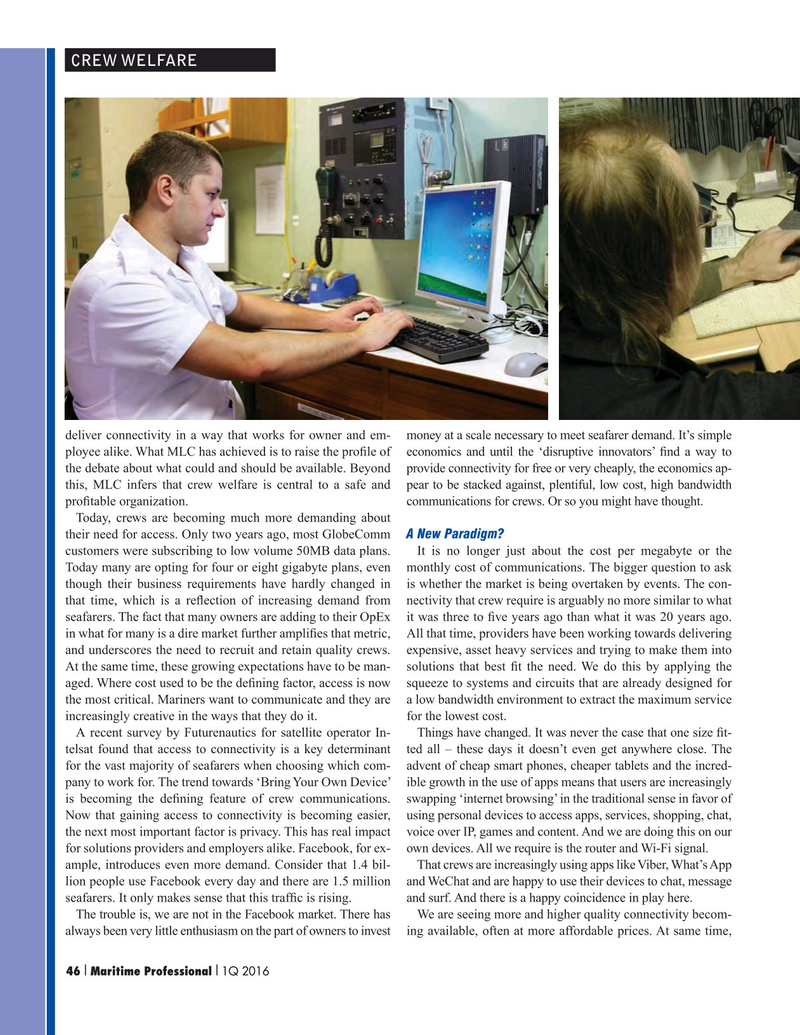
Page 46: of Maritime Logistics Professional Magazine (Q1 2016)
Maritime Training and Education
Read this page in Pdf, Flash or Html5 edition of Q1 2016 Maritime Logistics Professional Magazine
CREW WELFARE deliver connectivity in a way that works for owner and em- money at a scale necessary to meet seafarer demand. It’s simple ployee alike. What MLC has achieved is to raise the pro? le of economics and until the ‘disruptive innovators’ ? nd a way to the debate about what could and should be available. Beyond provide connectivity for free or very cheaply, the economics ap- this, MLC infers that crew welfare is central to a safe and pear to be stacked against, plentiful, low cost, high bandwidth pro? table organization. communications for crews. Or so you might have thought.
Today, crews are becoming much more demanding about their need for access. Only two years ago, most GlobeComm A New Paradigm?
customers were subscribing to low volume 50MB data plans. It is no longer just about the cost per megabyte or the
Today many are opting for four or eight gigabyte plans, even monthly cost of communications. The bigger question to ask though their business requirements have hardly changed in is whether the market is being overtaken by events. The con- that time, which is a re? ection of increasing demand from nectivity that crew require is arguably no more similar to what seafarers. The fact that many owners are adding to their OpEx it was three to ? ve years ago than what it was 20 years ago. in what for many is a dire market further ampli? es that metric, All that time, providers have been working towards delivering and underscores the need to recruit and retain quality crews. expensive, asset heavy services and trying to make them into
At the same time, these growing expectations have to be man- solutions that best ? t the need. We do this by applying the aged. Where cost used to be the de? ning factor, access is now squeeze to systems and circuits that are already designed for the most critical. Mariners want to communicate and they are a low bandwidth environment to extract the maximum service increasingly creative in the ways that they do it. for the lowest cost.
A recent survey by Futurenautics for satellite operator In- Things have changed. It was never the case that one size ? t- telsat found that access to connectivity is a key determinant ted all – these days it doesn’t even get anywhere close. The for the vast majority of seafarers when choosing which com- advent of cheap smart phones, cheaper tablets and the incred- pany to work for. The trend towards ‘Bring Your Own Device’ ible growth in the use of apps means that users are increasingly is becoming the de? ning feature of crew communications. swapping ‘internet browsing’ in the traditional sense in favor of
Now that gaining access to connectivity is becoming easier, using personal devices to access apps, services, shopping, chat, the next most important factor is privacy. This has real impact voice over IP, games and content. And we are doing this on our for solutions providers and employers alike. Facebook, for ex- own devices. All we require is the router and Wi-Fi signal.
ample, introduces even more demand. Consider that 1.4 bil- That crews are increasingly using apps like Viber, What’s App lion people use Facebook every day and there are 1.5 million and WeChat and are happy to use their devices to chat, message seafarers. It only makes sense that this traf? c is rising. and surf. And there is a happy coincidence in play here.
The trouble is, we are not in the Facebook market. There has We are seeing more and higher quality connectivity becom- always been very little enthusiasm on the part of owners to invest ing available, often at more affordable prices. At same time, 46 Maritime Professional 1Q 2016I I 34-49 Q1 MP2016.indd 46 2/29/2016 11:14:45 AM

 45
45

 47
47
